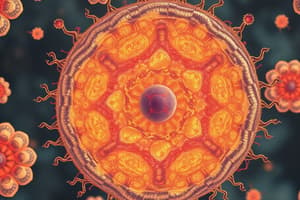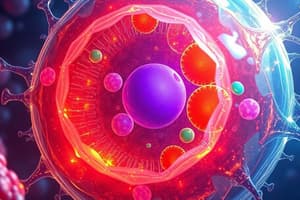Podcast
Questions and Answers
What is the primary function of the cell membrane in a eukaryotic cell?
What is the primary function of the cell membrane in a eukaryotic cell?
- To store the cell's genetic material
- To control the entry and exit of molecules (correct)
- To facilitate cell division and growth
- To provide structural support for the cell
Which of the following components is responsible for controlling gene expression and cell division in a eukaryotic cell?
Which of the following components is responsible for controlling gene expression and cell division in a eukaryotic cell?
- Cell membrane
- Organelles
- Cytoplasm
- Nucleus (correct)
What is the primary function of the phospholipid bilayer in the cell membrane?
What is the primary function of the phospholipid bilayer in the cell membrane?
- To act as a barrier and regulate the flow of materials (correct)
- To provide structural support for the cell
- To facilitate the transport of large molecules
- To anchor the membrane to the cytoskeleton
Which of the following is a key characteristic of prokaryotic cells that distinguishes them from eukaryotic cells?
Which of the following is a key characteristic of prokaryotic cells that distinguishes them from eukaryotic cells?
What is the primary role of the cytoplasm in a eukaryotic cell?
What is the primary role of the cytoplasm in a eukaryotic cell?
Which of the following organelles is responsible for the production of energy in a eukaryotic cell?
Which of the following organelles is responsible for the production of energy in a eukaryotic cell?
What is the function of ribosomes within eukaryotic cells?
What is the function of ribosomes within eukaryotic cells?
Which organelle is responsible for generating cellular energy through cellular respiration?
Which organelle is responsible for generating cellular energy through cellular respiration?
What is the main function of the Golgi apparatus within a cell?
What is the main function of the Golgi apparatus within a cell?
Where are ribosomal RNA subunits produced within a eukaryotic cell?
Where are ribosomal RNA subunits produced within a eukaryotic cell?
Which organelle is responsible for breaking down waste materials and foreign substances in a cell?
Which organelle is responsible for breaking down waste materials and foreign substances in a cell?
In which organelle do materials move via diffusion in a cell?
In which organelle do materials move via diffusion in a cell?
Flashcards are hidden until you start studying
Study Notes
Cell Structure
Cells are the fundamental organizational units of living organisms, carrying out a wide array of functions crucial to sustaining life. They come in various forms, shapes, and sizes, yet share common characteristics due to their shared responsibility for maintaining life processes. Two primary types of cells exist: prokaryotic and eukaryotic. The latter category, eukaryotes, possesses membrane-bound organelles, contributing to their diverse functionality within organisms.
Components of a Eukaryotic Cell
Eukaryotic cells consist of several key components, including the cell membrane, nucleus, cytoplasm, and various organelles.
Cell Membrane (Plasma Membrane)
A cell membrane, also referred to as a plasma membrane, encases a eukaryotic cell. This semipermeable barrier allows the controlled entry and exit of molecules, regulating the flow of materials into and out of the cell. The membrane is composed of a phospholipid bilayer, with integral and peripheral proteins responsible for various functions such as anchoring the membrane to the cytoskeleton, acting as receptors for signaling molecules, and transporting molecules across the membrane.
Nucleus
The nucleus is the central hub of a eukaryotic cell, housing the cell's genetic material, DNA. Surrounded by the nuclear membrane, the nucleus is responsible for controlling cell growth, division, and regulating gene expression. The nucleus also contains the nucleolus, a region where ribosomal RNA subunits are produced.
Cytoplasm
The cytoplasm is the jelly-like substance filling the space outside the nucleus and between the organelles within the cell. It serves as a medium for chemical reactions and supports the organization of organelles. Materials within the cytoplasm move via diffusion, although longer distances require active transport mechanisms.
Organelles within Eukaryotic Cells
Organelles are membrane-bound structures within eukaryotic cells, performing specialized functions to maintain the cell's health and efficiency. Some prominent examples include:
Mitochondria
Mitochondria are responsible for generating cellular energy through a process called cellular respiration. They produce adenosine triphosphate (ATP), which powers various cellular processes.
Ribosomes
Ribosomes translate messenger RNA into proteins, effectively converting genetic information into functional proteins necessary for cellular functions.
Endoplasmic Reticulum (ER)
The endoplasmic reticulum is an extensive network of tubules that fold and form channels within the cytoplasm. It plays a role in protein synthesis, lipid biosynthesis, and metabolism.
Golgi Apparatus
The Golgi apparatus modifies, sorts, and packages proteins, lipids, and carbohydrates produced by the ER, preparing them for transport to their final destinations within the cell or secretion from the cell.
Lysosomes
Lysosomes contain digestive enzymes responsible for breaking down waste materials, cellular debris, and foreign substances like bacteria that invade the cell.
Conclusion
In summary, eukaryotic cells possess a complex structure with distinct compartments that promote specialized functions essential for life processes. The organization of these components allows eukaryotic cells to carry out intricate tasks, ultimately contributing to the overall health and functionality of multicellular organisms.
Studying That Suits You
Use AI to generate personalized quizzes and flashcards to suit your learning preferences.




